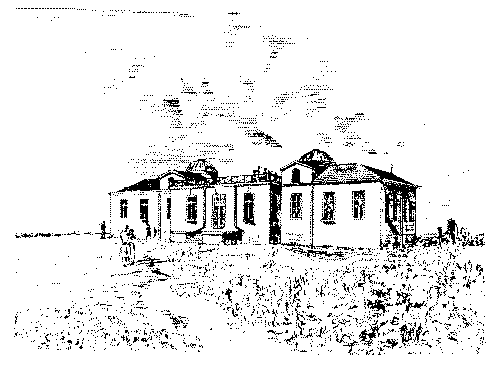| 1803–1805 |
Observing station in the north-west-tower of the former College
of the Jesuits in Neuhauser Street (Centre of Munich) to fulfil
requirements of the Bavarian Survey. |
| 1805–1816 |
New station near the villages of Haidhausen / Ramersdorf
close to Munich (today: area covered by Eastern Railway Station
of Munich). By order of King Max I Joseph the Bavarian Academy of
Sciences starts the construction of a new Royal Observatory just
outside the village of Bogenhausen, well beyond the bustle of
Munich. |
|
Figure 2:
The Royal Observatory in Bogenhausen around 1820. |
| 1817–1819 |
Delivery and installation of astronomical instruments
manufactured in the famous mechanical-optical workshops
of Utzschneider, Reichenbach, Liebherr, and Fraunhofer.
The Royal Observatory constitutes the best-equipped observatory
in the world. |
|
Figure 3:
Meridian Circle delivered by Reichenbach and Ertel (Munich).
The photo was taken around the turn of the century. |
| 1820 |
Fraunhofer and Soldner, the director of the observatory,
lay foundations of stellar spectroscopy, one of the most
important observing techniques of modern astrophysics. |
| 1835 |
A telescope, ordered originally from Fraunhofer and
completed by his successor, is being installed on the observatory
site. For the next four years this 10.5-inch-Refractor is the
best telescope in the world and remains in use until 1969. |
|
Figure 5:
The 10.5 inch refractor, originally designed by Fraunhofer and
manufactured by his successor Merz, was put into operation in 1835.
The telescope is still located in its historical building.
The photo was taken around 1900. |
| 1837 |
For the first time in history: Practicable telegraphic
information transmission (between the observatory and the physics
workshop of the Bavarian Academy of Sciences). |
| 1840–1879 |
Lamont, director since 1835, gains world fame for his
fundamental contributions to the research in terrestrial magnetism.
Further fields of activity: astrometry, meteorology, instrumentation. |
| 1852 |
One of the precision pendulum clocks is connected by
cable to the Bavarian Telegraph Office in Munich. From there,
the exact time, determined via meridian circles at the observatory, is
distributed throughout Bavaria. Some 70 years later, the Bavarian
Broadcasting Corporation takes over transmission of the time
signal received from the observatory. |
| 1882–1924 |
Seeliger, the most famous German astronomer of the
time, leads the observatory to world-wide recognition. Main activities:
Stellar statistics, theory of novae, photometry of dusty objects, astrometry,
error analysis as well as geophysical research and development of
instrumentation. However, with the city of Munich encroaching on and finally
engulfing the site, a period of slow decay sets in. |
|
Figure 8:
View of the Royal Observatory around the turn of the century. |
| 1938 |
Affiliation of the observatory to the Faculty of Natural
Sciences of the University of Munich. |
| 1944 |
Most buildings are severely affected by several bomb raids.
Reconstruction of the destroyed buildings is finished in 1954. |
| |
Figure 12:
The observatory after the bombing raids in July 1944. |
| 1949 |
Substantial changes in the observatory structure:
All geophysical equipment (at the observatory site and elsewhere
are removed and put under the responsibility of the newly founded Institute
for Geophysics at the University of Munich.
At the same time the Solar Observatory on top of
Mt. Wendelstein (some 75 km south-east of Munich)
is turned over to the state of Bavaria, which in turn places it
under the the jurisdiction of the University of Munich. It had been
established by the German Luftwaffe in 1941 and was under the
auspices of the American Army from the end of World War II. |
| |
Figure 15:
The Solar Observatory on top of Mt. Wendelstein. Solar measurements
were discontinued in 1987. A 0.8-m reflector for night
astronomy has been in operation since 1989. |
| 1955–1964 |
The need to catch up with the high level standard
of modern astrophysical research becomes evident. The
European Community endeavours to provide excellent observing
facilities for common use outside Europe, so the University of Munich
decides to make the first move in creating suitable structural
opportunities for research and teaching work. |
| 1964–1966 |
Demolition of the old observatory building and
construction of modern institute facilities on the
historical site. Main emphasis of activities is now in the fields
of astrophysics (e.g., stellar atmospheres) and design of
astronomical instruments. |
| |
Figure 14:
The new building of the Institute for Astronomy and Astrophysics
if the University of Munich, constructed in
1964–1966 on the historical site. |
| Present |
The Institute for Astronomy and Astrophysics has once
again attained an outstanding position in the international
astronomical community. Presently (1997), about 70 scientists,
engineers, PhD (astronomy) and diploma (physics) students are
working in the fields of instrumentation (spectrographs,
photometers, CCD-Cameras etc.), stellar astronomy (physics of
stellar atmospheres, stellar winds, stellar evolution, binaries,
cataclysmic variables etc.), atomic physics (quantum mechanical
calculation of transition probabilities), plasma physics (cosmic
magnetic fields), and extragalactic astronomy (galaxies, dark
matter etc.).
About 50% of all students of physics at the University of Munich
decide in favour of astronomy as an optional subject and
attend the required lectures, seminars and practicals.
Observing activities concentrate mainly on the European
Southern Observatory (ESO) at Mt. La Silla (Chile),
the Centro Astronomico Hispano Aleman at Mt. Calar Alto (Spain),
the Mauna Kea Observatory in Hawaii (USA), and on astronomical satellites
(e.g., ROSAT, HST). Observing projects are presently being developed for
realization with the Very Large Telescope (VLT) at
Mt. Paranal (Chile) after its completion in the near future.
Besides this, the institute operates a modern
0.8-m reflector at Mt. Wendelstein and has a share in the
9-m HET Telescope at the McDonald Observatory in Texas (USA). |
![[LMU logo]](/graphics/lmulogoboxes.png)
![[USM logo]](/graphics/usmlogo.png)
![[LMU seal]](/graphics/lmusiegelbox.png)
